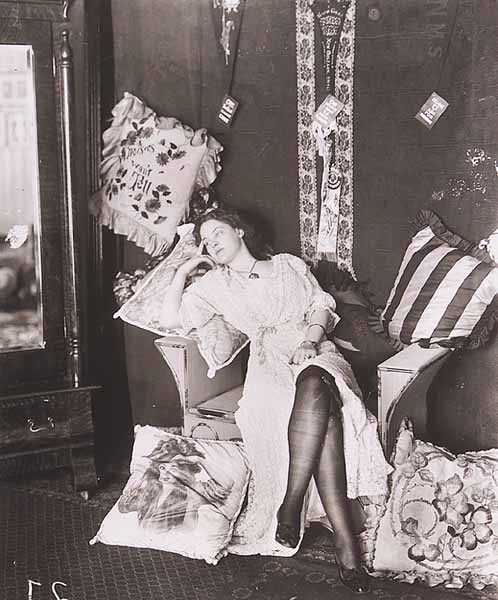
Seated Storyville woman (Photo by: Ernest J. Bellocq – Photo by E. J. Bellocq, print by Dan Leyrer from original glass negative)
A hundred years ago this year, legalized prostitution officially came to an end in New Orleans’ famed Storyville district, under World War I-era rules banning brothels near military sites.
And by the 1940s, most of Storyville’s bars, bordellos and music halls had been torn down to make way for the Iberville public housing project, itself razed earlier this decade. But an exhibition opening in April at The Historic New Orleans Collection will revisit the area’s roughly 20-year reign as the city’s sanctioned red-light district, a subject that continues to fascinate even a century later.
“It’s an aura of glamour about what is essentially a kind of sordid activity from the past— the idea of a concentrated red light district where there are these powerful madams with elaborate and costly mansions where beautiful girls were entertainers for wealthy men,” says Pamela D. Arceneaux, senior librarian and rare books curator at HNOC.
The exhibit, titled “Storyville: Madams and Music,” will include some of the architectural fragments of Storyville—an area just outside of the French Quarter that was ironically named for city Alderman Sidney Story, who sought to curtail the sex trade by confining it to a limited region—that have survived the decades since. Those include a decorated transom window that once adorned famed madam Lulu White’s entry and was recently acquired by HNOC.
“It’s a fairly large piece—rather amazing that something of such fragility should still have been preserved,” says Arceneaux.
Visitors will also be able to see musical instruments and sheet music played by musicians in Storyville. This year also marks the 100-year anniversary of the Original Dixieland Jass Band’s “Livery Stable Blues,” considered the first widely circulated jazz record. But HNOC assistant curator and historian Eric Seiferth emphasizes that Storyville musicians played everything from ragtime tunes to overtures from popular operas to keep their audiences entertained.
“You have piano players, you have string bands, you have brass bands, and they’re playing ragtime, they’re playing Tin Pan Alley hits,” he says.
The exhibition will also feature Storyville Blue Books—the guides to nightlife and prostitution in the district that were typically published around Mardi Gras to take advantage of the influx of tourists to New Orleans. The HNOC has the most comprehensive known collection of the books, says Arceneaux, who is also the author of Guidebooks to Sin, an illustrated examination of the books published in February. The Carnival-time releases helped Arceneaux figure out which years some of the undated books were released, by matching the dates of Mardi Gras balls to when the holiday fell in different years.
Listings boasting of the beauty and charm of Storyville venues and prostitutes ran alongside ads for beverages like Veuve Clicquot and Pabst Blue Ribbon, in the years before first prostitution, then alcohol, would be officially banned.
“They are targeting an audience—an audience of upwardly mobile, largely white men who are coming to the district,” says Arceneaux.
The books also included ads for legal services and venereal disease cures for men who may have had reason to regret their visits to the district. And while many of the women who worked in the brothels may have suffered their own unpleasant fates or simply moved on, the Blue Books also show how some were able to effectively rise through the profession, she says.
“In an early guidebook, a woman may be listed working for a madam,” says Arceneaux. “Two or three or four editions later, she’s running her own house.”
But even with the surviving Blue Books and other artifacts, there’s still a lot that’s just not known about the details of life in the area.
“We probably know more about the Egyptian Middle Kingdom or classical Greece from ruins than we know about Storyville, because it was so utterly obliterated,” says John H. Lawrence, HNOC’s director of museum programs. “For something that seemed to be as white-hot an attraction in New Orleans for that period, where documentation was not an issue—I mean, people did not have to set up easels and paint what was going on there—there’s remarkably small portions of the historical record that would give people an understanding.”
The exhibition “Storyville: Madams and Music,” will be on view at The Historic New Orleans Collection’s Williams Research Center, 410 Chartres St., from April 5 until Dec. 2, 2017.
 NOLAbeings Multimedia artist Claire Bangser created NOLAbeings as a portrait-based story project that marries...
NOLAbeings Multimedia artist Claire Bangser created NOLAbeings as a portrait-based story project that marries...  Voodoo in New Orleans: Reviving history: New Orleans fortune telling This article takes a deep dive into the history of Voodoo in New Orleans, its hybridization with Catholicism, and its present-day place in the city's culture. The author visits fortune-tellers in the French Quarter, using their guidance as a tool for introspection rather than a deterministic predictor of the future. Through her experiences in New Orleans, the author feels a mystical connection to both the past and the future.
Voodoo in New Orleans: Reviving history: New Orleans fortune telling This article takes a deep dive into the history of Voodoo in New Orleans, its hybridization with Catholicism, and its present-day place in the city's culture. The author visits fortune-tellers in the French Quarter, using their guidance as a tool for introspection rather than a deterministic predictor of the future. Through her experiences in New Orleans, the author feels a mystical connection to both the past and the future. 